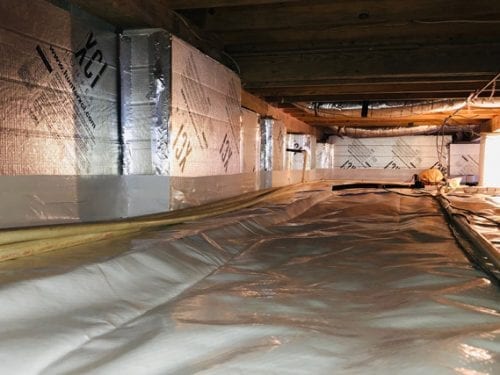Have you ever walked into your basement and been hit with that unmistakable damp, musty smell? Maybe you’ve noticed condensation on the windows, damp spots on the walls, or even the unwelcome sight of mold creeping into corners. If so, you’re not alone. Basements are notorious for trapping moisture, and when left unchecked, excess humidity can lead to serious problems—mold growth, structural damage, and even a decline in the overall air quality of your home.
Think about it: your basement is underground, surrounded by soil that holds moisture. When that moisture seeps in, it doesn’t just stay in the basement—it rises into your living spaces, impacting your entire home’s environment. That’s why controlling basement humidity levels is about more than just comfort; it’s about protecting your home and health.
Read on to know everything you need to create a moisture-free basement that feels fresh, clean, and problem-free.
Understanding Basement Humidity: Why Is It So Damp?
Basements are prone to high humidity levels due to their location underground. Here’s why moisture builds up:
Poor Drainage Around the Foundation
Water naturally accumulates in the soil surrounding your home. Without proper drainage, moisture seeps through foundation cracks, increasing humidity inside.
Lack of Ventilation
Basements have fewer windows and less airflow, meaning humid air gets trapped more easily.
Daily Household Activities
Washing clothes, showering, or cooking in the basement releases moisture into the air, raising humidity levels for the basement.
Warm Outdoor Air Entering the Basement
Opening basement windows during humid weather can actually make things worse—warm air enters and condenses on cooler surfaces, increasing moisture.
What’s the Ideal Humidity Level for a Basement?
The ideal basement humidity in summer and year-round is between 30% and 50%. Keeping humidity below 50% prevents mold growth and protects stored items from moisture damage.
Warning Signs Your Basement Humidity is Too High:
- Condensation on windows or walls
- A musty odor
- Visible mold growth
- Rust on metal objects
- Water stains or efflorescence on walls
If you notice any of these signs, it’s time to take action.
How to Lower Humidity in Your Basement
Reducing basement humidity levels requires a combination of moisture prevention and air management. Here’s what works best:
Install a Drain Tile System
A drain tile system is the most effective way to control moisture in the foundation. It redirects water away from your basement, preventing humidity buildup. There are two types:
- Exterior Drain Tile: Installed around the foundation’s perimeter to collect and expel water.
- Interior Drain Tile: Placed inside the basement along the floor edges, collecting water before it enters the space.
While a drain tile system is a highly effective solution, there are additional steps you can take to ensure long-term moisture control. Read more about these strategies in this year-round basement drying guide.
Use a Dehumidifier
A dehumidifier helps maintain the ideal basement humidity level by removing excess moisture from the air. Look for models with automatic humidity controls to keep levels between 30%-50%.
Improve Basement Ventilation
- Use exhaust fans to circulate air and reduce humidity buildup.
- Avoid opening windows on humid days; instead, use a dehumidifier.
- If possible, integrate basement air circulation into your home’s HVAC system.
Seal Cracks and Leaks
- Check for foundation cracks or gaps where water may be entering.
- Use waterproof caulk or hydraulic cement to seal small cracks.
- For serious foundation leaks, consider professional waterproofing solutions.
Regrade Your Yard for Better Drainage
Ensure that your yard slopes away from your home, directing rainwater away from the foundation.
Extend Downspouts and Clean Gutters
- Downspouts should direct water at least 10 feet away from your foundation.
- Clogged gutters cause water overflow, leading to basement leaks—clean them regularly.
Insulate Pipes to Prevent Condensation
Cold basement pipes can collect moisture from humid air, leading to dripping and increased humidity. Insulating pipes reduces condensation buildup.
Long-Term Solutions to Stop Moisture in Your Basement
While dehumidifiers and ventilation help manage humidity, addressing the root cause ensures long-term success. Here’s what to consider to remove humidity from basement:
Install a Sump Pump
A sump pump removes water that collects in the basement, preventing excessive moisture buildup. Choose a model with a battery backup to ensure it works during power outages.
Apply Waterproof Coatings to Walls
Waterproof sealants on basement walls help block moisture. These coatings provide an additional barrier against seepage.
Invest in a Basement Waterproofing System
For homes with persistent moisture issues and high humidity level for the basement, professional basement waterproofing solutions may be necessary. Options include:
- Interior drainage systems
- Vapor barriers
- French drains
Keep Your Basement Dry and Comfortable Year-Round
Humidity problems in basements are incredibly common, but that doesn’t mean you have to live with them.
Ignoring humidity issues won’t make them go away—in fact, they’ll only get worse over time. With the right steps, you can take control and create a basement that’s clean, dry, and safe for storage or even additional living space.
Don’t wait until basement humidity levels damage takes a toll on your basement and belongings. Whether it’s a simple fix like sealing cracks or a more advanced solution like installing a sump pump, acting now can save you time, money, and stress in the long run.
If you want to understand how to stop moisture in the basement or looking for expert guidance on basement waterproofing – contact us today for a free consultation and get started on a moisture-free basement!







